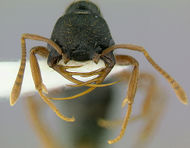Key to Thaumatomyrmex of Cuba
This worker key is based on: Baroni Urbani, C. and M. L. de Andrade. 2003. The ant genus Thaumatomyrmex in Cuba (Hymentoptera: Formicidae) with description of two new species. Mitt. Schweiz. Entomol. Ges. 76:263-277.
You may also be interested in
1
- Mandibles at rest surpassing laterally the genae and the eyes (Figs 3 & 4). Mandibular length (ML) > 1.00 mm. Hind femora (HFe) at least 1/5 shorter than length of the mandibles . . . . . 2
- Mandibles at rest surpassing at most the genae but never the eyes (Figs I & 2). Mandibular length (ML) < 0.82. Hind femora (HFe) subequal in length to the mandibles . . . . . 3
2
return to couplet #1
- Head very broad anteriorly (HW1 > 1.14) (Fig. 4). Scape length (SL) > 0.75. Total length> 4.87 mm . . . . . Thaumatomyrmex mandibularis
- Head narrower anteriorly (HW1 < 0.96) (Fig. 3). Scape length (SL) < 0.64. Total length= 4.20 mm . . . . . Thaumatomyrmex bariay
3
return to couplet #1
- Sides of the mesosoma minutely punctate-reticulate. Sides of the petiole and of the gaster with dense anastomosing canaliculation and rare piligerous foveae. Hairs short and sparse (Fig. 1). CI2 > 105 . . . . . Thaumatomyrmex nageli
- Sides of the mesosoma with large and sparse piligerous punctures. Sides of the petiole and of the gaster with dense piligerous punctures and rare anastomosing canaliculation. Hairs long and dense. (Fig. 2). CI2 < 103 . . . . . Thaumatomyrmex cochlearis



